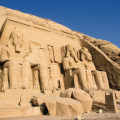TEMPLE OF RAMSES II
Go there and contact
The great temple of Abu Simbel was the brainchild of Ramses II. It took almost 20 years to build it out of the rock, and from it emerged this major architectural masterpiece of antiquity. It is dedicated to Amun-Ra, the most powerful god of the Theban cult, to Ra-Harakhty, who dominates the Heliopolitan cult, to Ptah, the center of the Memphis cult, and to Ramses II, the deified god.
The politico-religious significance of this temple is monumental, as if Pharaoh wanted to bring together here the three Egyptian cults, each of which had its hour of glory. He himself, by divinizing himself, as is his right since he is the successor to Ra, who was succeeded by Shu, then Gheb, then Osiris, then Horus, then Pharaoh, whose cycle continues up to him, son of Seti I, of the 19th dynasty, victorious in so many victories over his enemies, and builder of so many temples dedicated to the cult of his successor, Ra.
The temple's façade is preceded by 4 monumental statues of Ramses II seated, accompanied by his beloved wife, Nefertari, his mother, Mouttouy, and his sons and daughters. They reach heights of over 20 m. In the niche surmounting the temple entrance, the falcon-headed Ra-Harakhty stands erect, surmounted by the solar globe. A frieze of baboons completes the upper part of the façade.
A short corridor leads into the first hypostyle hall, supported by eight Osirid statues in the guise of Ramses II. On the left, they wear the white crown of Upper Egypt, on the right the double crown of the united country. The walls magnify royal victories, particularly that of Qadesh over the Hittites.
This leads into a second hypostyle hall with 4 square pillars, where Pharaoh presents offerings to the major deities of the Egyptian pantheon. A vestibule follows this hall into the sanctuary, where four seated statues stand impassively awaiting today's visitor, the priest of Amun in Pharaoh's time. These are the three major gods of the three cults and that of Ramses II.
Various chambers cut into the rock expand the ten-room temple, decorated with bas-reliefs in different colors. The axis of the temple doorway to the sanctuary was designed so that the sun would strike the statues on October 22 and February 22 of each year to celebrate festivities dear to Ramses II.
You can also visit the modern structure that backs onto the temple, which was cut up and assembled here when it was moved prior to the construction of the Aswan Dam. The contrast is interesting.
Did you know? This review was written by our professional authors.
Members' reviews on TEMPLE OF RAMSES II
The ratings and reviews below reflect the subjective opinions of members and not the opinion of The Little Witty.









Je n'insiste pas sur la première impression ressentie au détour des chemins lorsqu'on découvre les statues de Ramses.
Il faut néanmoins savoir qu'en bus l'excursion est interminable : environ 4 h 30 à l'aller pour a peu près 1h 1h 15 sur place. C'est très rapide et laisse peu de temps pour profiter su site et faire des photos d'autant qu'il y a beaucoup de monde sur un site finalement plutôt petit.
Par ailleurs, les guides n'ont pas le droit de commenter à l'intérieur des temples. Ils restent donc à bonne distance pour leurs explications puis vous laissent quartier libre 1h.
A moins d'avoir un guide exceptionnel sur votre bateau (ce n'était pas notre cas), je ne conseille pas forcément de réserver l'excursion du bateau. C'est très cher. Environ 100 €. J'ai réservé sur un site d'excursion spécialisé. Pour la même prestation (guide francophone + transport en minibus) j'ai payé moins de 30 € + environ 10 € l'entrée sur le site d'où à 5 une sacrée économie. Aucun soucis sur place. Le bus m'attendait à la sortie du bateau. Ce guide n'ayant fait néanmoins que dormir tout le long du trajet, j'aurais mieux fait de ne réserver que le transport. C'était encore moins cher et avec mon petit futé préféré dans la poche, cela suffisait amplement
Il est impressionnant d'imaginer le travail qu'il a fallu réaliser pour ça.
Et bien sûr, très intéressant en tant que monument égyptien.
La durée du transport d'Assouan est moins agréable, mais il faut ce qu'il faut.
La taille,
Les détails et même les couleurs